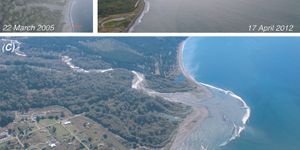The issue of carbon emissions and their effect on the environment can be complex. Indeed, most of the current science concerning climate change credits carbon dioxide for some of the effects on the planet's weather, the changes in sea levels and Arctic ice and of course rising temperatures.
Carbon dioxide is a key player in all of these processes.
It's about a balance, as so many things are. The basic equation has two parts. The first is that living plants and trees will absorb carbon dioxide from their surroundings. Naturally it then follows that what goes in, must eventually come out. The other half of the equation is that dead trees, or even those just decomposing, actually give off carbon dioxide. Understanding this balance is vital to determining how best to manage land use.

Scientists estimate that close to 25% of greenhouse gas emissions come from our forested areas, crops and plant life. Only the energy sector is puts out more greenhouse gas so while finding new sources of energy is important, so is the study of forested areas.
A team from The Imperial College London has released a study on tropical rainforest areas that have been partially logged and their results show that the levels of carbon being given off by these areas has been underestimated. The reason is that once logging has begun on any forested area, there is good portion of dead wood left behind.
The journal Environmental Research Letters published the recent study and the numbers show that it's the composition of the biomass that is significant. Biomass is the amount of biological material that sits above ground. In a partially harvested forest, the dead wood remnants that remain after logging can account for up to 64% of the biomass.
There is still dead wood in forests that have not been logged, however it is created naturally and estimates put the percentage at less than 20% of the total biomass.
Before these latest numbers were calculated the assumption was that when trees are cut down and taken from the forest, the dead wood left behind is also reduced, in amounts proportional to the live trees that were harvested. That doesn't seem to be the case however as the new research demonstrates.
Dr. Marion Pfeifer, the lead author of the study from the Life Sciences Department at Imperial College said in an article written by Hayley Dunning,
"I was surprised by how much of the biomass dead wood accounted for in badly logged forests."
It appears that not all forests are harvested in the same way. Selective logging is when only the high value trees are removed. This method does a great deal of damage to the forest, leaving behind much more debris and dead wood than previously understood.
Dr. Pfeifer and her colleagues studied a wide range of land in Malaysian Borneo, in an area
of rainforest known as a Stability of Altered Forest Ecosystems (SAFE) site, an environmental experiment that can track changes in the ecosystem as land use is converted to oil palm plantations. The types of land they surveyed included untouched forests, partially logged forests and plantation areas.
Dr Pfiefer said in a statement published by the Imperial College, "Selectively-logged tropical forests now make up about 30 per cent of rainforests worldwide. This means such global calculations are wrong at least 30 per cent of the time." said Dr Pfeifer.
"That such logged forests are not properly accounted for in carbon calculations is a significant factor."
While pleased with the initial results and confident in the calculations made in the study, Dr. Pfeifer believes more research is needed, especially in determining the rate of decomposition in the debris and dead wood left behind after logging.
(Sources: Science Daily, Imperial College of London, Wikipedia)









